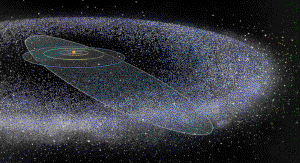Blog
Seeking a Companion
12 January 2014
 Don Dixon
Don DixonEvery now and then rumors of some companion star or planet to the Sun hits the web. The most infamous of these is the Nibiru hypothesis, which claims that a large planet will sweep into the inner solar system, sending Earth to its doom. While claims of Nibiru have always been unfounded, there has been legitimate speculation about a possible companion to the Sun, either a small star or large planet with an orbit that takes it to the edge of our solar system.
One of these ideas was a companion star known as Nemesis. The idea for Nemesis came from a periodicity seen in the rates of extinctions in the fossil record. It was first noticed in 1984 that the rate of extinctions seemed to spike every 27 million years, going back about 500 million years. This led several astronomers to propose a companion star, which came to be known as Nemesis, as the cause of these extinctions. The idea was that Nemesis to the Sun could be in an elliptical orbit that takes it into region of the Oort cloud. Its gravitational interaction would then disrupt bodies in the Oort cloud, leading to a dramatic increase in comets sent toward the inner solar system. The higher impact rate would then lead to periodic extinctions.
This idea is no longer considered valid for two reasons. For one, there isn’t any evidence that the periodic extinctions is correlated with higher impact rates in the inner solar system. For another, a companion star with a period of 27 million years would need to have an orbital radius of about 1.5 light years. This would put it so far away from the Sun at times that the gravitational interactions with other stars would cause its orbit to fluctuate. Orbital simulations show that the orbit of such a star could not be stable over 500 million years.1 So even if the periodic extinctions were due to higher impact rates, it can’t be due to a Nemesis star.
Another companion idea comes from an analysis of long period comets. Long period comets are ones that come from the far regions of the solar system, and swing into the inner solar system before heading out again. Comet ISON was a long period comet, for example. These comets generally come from all directions, which is why they are thought to originate in the Oort cloud.
But in 1999, John Matese, Patrick Whitman and Daniel Whitmire argued that there was a slight bias in the origins of these comets.2 Rather than coming from random directions, they were slightly more likely to originate from directions along the plane of the solar system. They proposed that this could be explained by the presence of a large gas planet with an orbital radius of about 15,000 AU, or 500 times farther from the Sun than Neptune, which they named Tyche.
Tyche (if it existed) would be detectable by the Wide-field Infrared Survey Explorer (WISE), an infrared space telescope. Now a new paper in the Astrophysical Journal has presented new results that show Tyche doesn’t exist.3 In the paper, the author analyzed WISE data over an extended period of observations looking for the motion of dim objects.
The more massive a planet, the warmer it would be from its own internal heat, and therefore the brighter it would be at infrared wavelengths. The survey found no companion objects larger than Jupiter closer than 82,000 AU, or Saturn at 28,000 AU. This is much farther than the proposed distance of Tyche. It is, in fact in the region of the proposed distance of Nemesis.
So it looks like the Sun doesn’t have any companions larger than Jupiter, at least within 1.3 light years.
Melott, Adrian L., and Richard K. Bambach. “Nemesis reconsidered.” Monthly Notices of the Royal Astronomical Society: Letters 407.1 (2010): L99-L102. ↩︎
Matese, John J., P. G. Whitman, and D. P. Whitmire. “Cometary evidence of a massive body in the outer Oort clouds.” Icarus 141.2 (1999): 354-366. ↩︎
Luhman, Kevin L. “A search for a distant companion to the sun with the wide-field infrared survey explorer.” The Astrophysical Journal 781.1 (2013): 4. ↩︎